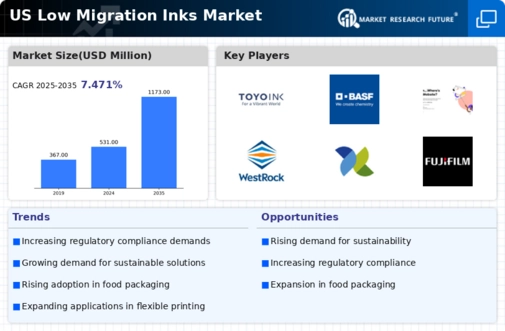The low migration inks market is characterized by a competitive landscape that is increasingly shaped by innovation and sustainability. Key players such as Sun Chemical (US), Flint Group (US), and Toyo Ink SC Holdings Co., Ltd. (US) are actively pursuing strategies that emphasize product development and environmental responsibility. Sun Chemical (US) has positioned itself as a leader in sustainable ink solutions, focusing on the development of low migration inks that meet stringent regulatory requirements. Meanwhile, Flint Group (US) has been enhancing its product portfolio through strategic partnerships and technological advancements, aiming to cater to the growing demand for safe packaging solutions. These strategies collectively contribute to a dynamic competitive environment, where innovation and compliance are paramount.
In terms of business tactics, companies are increasingly localizing manufacturing to reduce lead times and enhance supply chain efficiency. The market appears moderately fragmented, with several players vying for market share while also collaborating on sustainability initiatives. This competitive structure allows for a diverse range of products and solutions, catering to various customer needs while fostering innovation.
In November 2025, Toyo Ink SC Holdings Co., Ltd. (Japan) announced the launch of a new line of low migration inks specifically designed for food packaging applications. This strategic move underscores the company's commitment to meeting the evolving demands of the food industry, where safety and compliance are critical. By introducing these specialized inks, Toyo Ink SC Holdings Co., Ltd. (Japan) aims to strengthen its market position and address the growing consumer preference for safe packaging materials.
In October 2025, Flint Group (US) expanded its collaboration with a leading packaging manufacturer to develop customized low migration ink solutions. This partnership is significant as it allows Flint Group (US) to leverage its technological expertise while addressing specific customer requirements. Such collaborations are likely to enhance product offerings and drive innovation within the market, positioning Flint Group (US) as a key player in the low migration inks segment.
In September 2025, Sun Chemical (US) unveiled a new sustainability initiative aimed at reducing the environmental impact of its ink production processes. This initiative includes the adoption of renewable energy sources and the implementation of waste reduction strategies. The strategic importance of this move lies in its alignment with global sustainability trends, which are increasingly influencing consumer preferences and regulatory frameworks. By prioritizing sustainability, Sun Chemical (US) is not only enhancing its brand reputation but also ensuring compliance with future regulations.
As of December 2025, the competitive trends in the low migration inks market are heavily influenced by digitalization, sustainability, and the integration of advanced technologies such as AI. Strategic alliances are becoming more prevalent, as companies recognize the need to collaborate in order to innovate and meet regulatory demands. Looking ahead, competitive differentiation is likely to evolve from traditional price-based competition to a focus on innovation, technology, and supply chain reliability. This shift suggests that companies that prioritize these aspects will be better positioned to thrive in an increasingly complex market.




















Leave a Comment